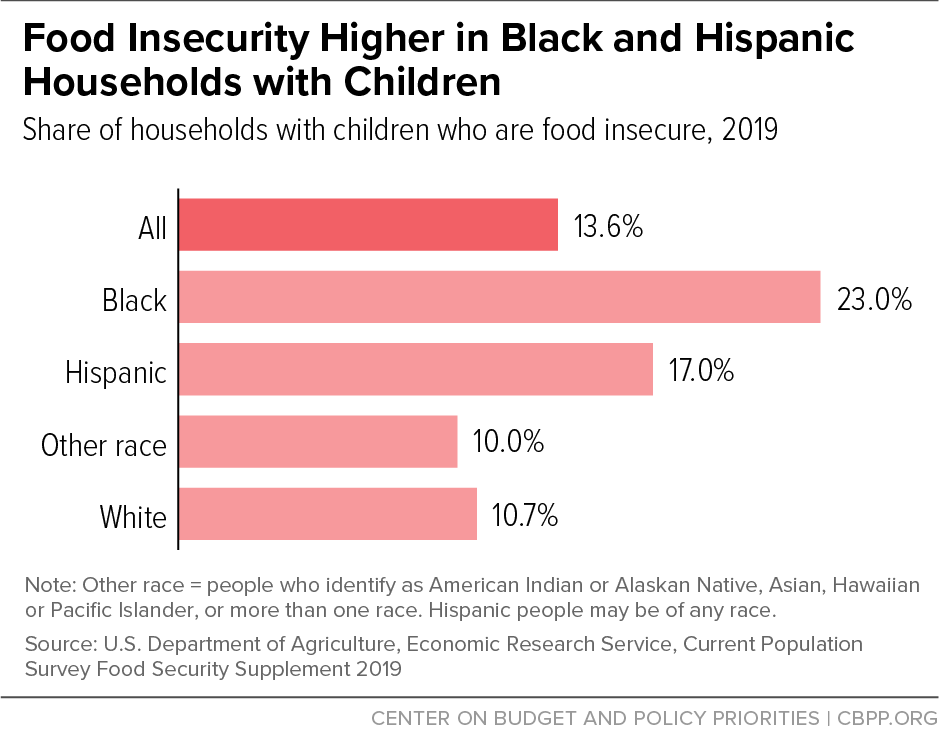Recent Increase in SNAP Purchasing Power Invests in Children’s Health and Well-Being
End Notes
[1] U.S. Department of Agriculture, “Thrifty Food Plan, 2021,” August 2021, https://FNS.usda.gov/TFP; Joseph Llobrera, Matt Saenz, and Lauren Hall, “USDA Announces Important SNAP Benefit Modernization,” CBPP, August 25, 2021, https://www.cbpp.org/research/food-assistance/usda-announces-important-snap-benefit-modernization.
[2] Steven Carlson, Joseph Llobrera, and Brynne Keith-Jennings, “More Adequate SNAP Benefits Would Help Millions of Participants Better Afford Food,” CBPP, updated July 15, 2021, https://www.cbpp.org/research/food-assistance/more-adequate-snap-benefits-would-help-millions-of-participants-better.
[3] We use data from the 2019 Current Population Survey Food Security Supplement, before Congress made temporary changes to SNAP during the COVID-19 pandemic. The rate of food insecurity among household with children rose slightly in 2020 to 14.8 percent, but relief measures prevented food insecurity from rising more than it did. See CBPP, “Robust COVID Relief Achieved Historic Gains Against Poverty and Hardship, Bolstered Economy,” February 24, 2022, https://www.cbpp.org/research/poverty-and-inequality/robust-covid-relief-achieved-historic-gains-against-poverty-and.
[4] In 2020, racial and ethnicity disparities in food insecurity rates among households with children worsened. The rate of food insecurity rose for Black households with children (to 27.3 percent) and Hispanic households with children (to 21.8 percent), while dropping (to 9.7 percent) for white households with children.
[5] Brynne Keith-Jennings, Catlin Nchako, and Joseph Llobrera, “Number of Families Struggling to Afford Food Rose Steeply in Pandemic and Remains High, Especially Among Children and Households of Color,” CBPP, April 27, 2021, https://www.cbpp.org/research/food-assistance/number-of-families-struggling-to-afford-food-rose-steeply-in-pandemic-and.
[6] Claire Zippel and Arloc Sherman, “Bolstering Family Income Is Essential to Helping Children Emerge Successfully From the Current Crisis,” CBPP, updated February 25, 2021, https://www.cbpp.org/research/poverty-and-inequality/bolstering-family-income-is-essential-to-helping-children-emerge.
[7] Anna Gassman-Pines and Laura Bellows, “Food Instability and Academic Achievement: A Quasi-Experiment Using SNAP Benefit Timing,” American Educational Research Journal, Vol. 55, No. 5, 2018, https://journals.sagepub.com/doi/10.3102/0002831218761337.
[8] Mark Nord and Mark Prell, “Food Security Improved Following the 2009 ARRA Increase in SNAP Benefits,” Economic Research Service, USDA, April 2011, https://www.ers.usda.gov/publications/pub-details/?pubid=44839; Jiyoon Kim, “Do SNAP participants expand non-food spending when they receive more SNAP Benefits?—Evidence from the 2009 SNAP benefits increase,” Food Policy, Vol. 65, December 2016, https://www.sciencedirect.com/science/article/abs/pii/S0306919216304341.
[9] Although the analysis does not focus specifically on families with children, its conclusions are relevant since nearly half of all SNAP households include children and two-thirds of all participants live in families with children. Mark Nord, “Effects of the Decline in the Real Value of SNAP Benefits From 2009 to 2011,” Economic Research Service, USDA, August 2013, https://www.ers.usda.gov/publications/pub-details/?pubid=45102; Bhagyashree Katare and Jiyoon Kim, “Effects of the 2013 SNAP Benefit Cut on Food Security,” Applied Economic Perspectives and Policy, Vol. 39, No. 4, December 2017, https://onlinelibrary.wiley.com/doi/abs/10.1093/aepp/ppx025.
[10] Most children in families with low incomes were eligible for Medicaid and the Children’s Health Insurance Program (CHIP) even before the Affordable Care Act. In the study sample, approximately 6 percent of low-income children had delayed care due to cost. Three percent and 4 percent of children in low-income households and low-income single-parent households, respectively, reported needing health care but not being able to afford it. Taryn Morrissey and Daniel Miller, “Supplemental Nutrition Assistance Program Participation Improves Children’s Health Care Use: An Analysis of the American Recovery and Reinvestment Act’s Natural Experiment,” Academic Pediatrics, Vol. 20, No. 6, August 2020, https://www.sciencedirect.com/science/article/abs/pii/S1876285919304619.
[11] Katelin Hudak and Elizabeth Racine, “Do additional SNAP benefits matter for child weight?: Evidence from the 2009 benefit increase,” Economics & Human Biology, Vol. 41, May 2021, https://www.sciencedirect.com/science/article/abs/pii/S1570677X20302367#.
[12] Colleen Heflin et al., “SNAP benefits and childhood asthma,” Social Science & Medicine, Vol. 220, January 2019, https://www.sciencedirect.com/science/article/abs/pii/S0277953618306294.
[13] Michele Ver Ploeg and Chen Zhen, “Changes in SNAP Benefit Levels and Food Spending and Diet Quality: Simulations from the National Household Food Acquisition and Purchase Survey,” CBPP, May 12, 2022, https://www.cbpp.org/research/food-assistance/changes-in-snap-benefit-levels-and-food-spending-and-diet-quality.
[14] National Academies of Sciences, Engineering, and Medicine, A Roadmap to Reducing Child Poverty, National Academies Press, 2019, http://sites.nationalacademies.org/dbasse/bcyf/reducing_child_poverty/index.htm.
[15] In 2017, SNAP kept about 6.5 million people above the poverty line, including 3.1 million children, according to a CBPP analysis that uses a version of the Supplemental Poverty Measure (SPM) — which, among other differences from the “official” poverty measure, counts non-cash benefits (like SNAP) and refundable tax credits — and corrects for households’ underreporting of benefits. The SPM also subtracts federal and state income taxes, federal payroll taxes, and certain non-discretionary expenses (such as out-of-pocket health costs and child care) from income when calculating what resources a family has available to buy basics such as food, clothing, and shelter. Under the SPM, a family is considered to be in poverty if its resources are below a poverty threshold ($27,005 for a two-adult, two-child family renting in an average-cost community in 2017) that accounts for differences in family composition and geographic differences in housing costs.
[16] These CBPP estimates are based on the U.S. Census Bureau’s March 2018 Current Population Survey, using tax year 2017 tax rules that account for the Tax Cuts and Jobs Act. The estimates include corrections for underreported benefits from SNAP, Supplemental Security Income, and Temporary Assistance for Needy Families from the Department of Health and Human Services/Urban Institute Transfer Income Model (TRIM). The estimates reflect a pre-pandemic economy and do not account for temporary measures enacted to reduce hardship during the pandemic, such as the temporary increase in the Child Tax Credit.

